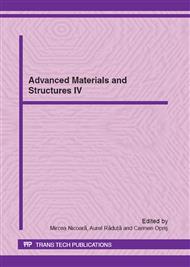p.11
p.15
p.21
p.27
p.31
p.37
p.41
p.46
p.52
Effect of Sintering Parameters on the Stability of Phases of the ZnFe2O4/α-Fe Nanocomposite
Abstract:
The ZnFe2O4/α-Fe nanocomposite powders were obtained by ball milling starting from ZnFe2O4 powder synthesized by classical ceramic method and commercial iron powder. Two way of milling were used for the synthesis of the ZnFe2O4/α-Fe nanocomposite. In both cases after milling process the phases are relatively uniformly distributed in material and zinc ferrite mean crystallite size decreases from micrometric range up to 11 nm for the first milling mode and up 48 nm for second milling mode. The ZnFe2O4/α-Fe nanocomposite powders were compacted by Spark Plasma Sintering method (SPS). During sintering a reaction between nanocomposite phases occurs, thus leading to the formation of ZnO and FeO. The evolution of the powders during milling and stability of the nanocomposite phases was investigated by X-ray diffraction. The powders and compacts morphology and local chemical homogeneity were investigated by scanning electron microscopy (SEM) and respectively by energy dispersive x-ray spectrometry (EDX). The influence of the sintering parameters on the stability of nanocomposites phases is studied.
Info:
Periodical:
Pages:
31-36
Citation:
Online since:
May 2012
Price:
Сopyright:
© 2012 Trans Tech Publications Ltd. All Rights Reserved
Share:
Citation:


